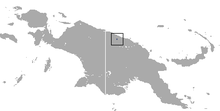Northern flying squirrel bucket
| Northern flying squirrel bucket | ||||||||||||
|---|---|---|---|---|---|---|---|---|---|---|---|---|
| Systematics | ||||||||||||
|
||||||||||||
| Scientific name | ||||||||||||
| Petaurus abidi | ||||||||||||
| Ziegler , 1981 |
The Northern Gliding Squirrel ( Petaurus abidi ) is a species of Gliding Squirrel (Petauridae) that only occurs in a small area in northern New Guinea . The species is found in Mount Somoro and its immediate vicinity in the Torricelli Mountains in the north of the Sandaun province in the northwest of Papua New Guinea . The species has one of the smallest distribution areas of all Melanesian mammals.
features
The northern flying squirrel bag reaches a head body length of 25 to 28 cm, has a 35 to 38 cm long tail and reaches a weight of 228 to 332 g. The back fur is light gray to yellowish brown. The yellowish-brown tint is most pronounced along the center line of the back. The species can be distinguished from the short-headed gliding pouch ( Petaurus breviceps ), which occurs throughout New Guinea, by its size and its almost completely black tail. In contrast to the Australian flying squirrel bucket, the fur of the northern flying squirrel bucket is long and dense and its tail is not bushy.
Habitat and way of life
The habitat of the Northern Gleithörnchenbeutler is a mossy, tropical primary forest. Most of the specimens have so far been observed at heights of 800 to 1200 meters, a few even below that at heights of 300 meters. The species is also found in weedy gardens in the immediate vicinity of the forest. Little is known about the way of life of the Northern Gleithörnchenbeutler. Some were caught eating figs. Captive specimens were fed on bananas, guavas, and fruits of Syzygium .
Danger
The IUCN classifies the northern flying squirrel hawk as critically endangered . The main reason is the small distribution area, which is only about 100 km², and the rarity of the animals. Only seven specimens have been caught in twenty years. It is possible that the species is more widespread and occurs in a larger area in the approximately 100 km long, little-explored Northern Coast Mountains.
supporting documents
- ↑ a b c Stephen Jackson: Family Petauridae (Striped Possums, Leadbeater's Possum and Lesser Gliders). P. 561 in Don E. Wilson , Russell A. Mittermeier : Handbook of the Mammals of the World - Volume 5. Monotremes and Marsupials. Lynx Editions, 2015, ISBN 978-84-96553-99-6
- ↑ Petaurus abidi in the Red List of Endangered Species of the IUCN 2016. Posted by: Leary, T., Wright, D., Hamilton, S., Singadan, R., Menzies, J., Bonaccorso, F., Salas, L. , Dickman, C. & Helgen, K., 2016. Retrieved June 21, 2018.
Web links
- Ziegler, Alan C. (1981). " Petaurus abidi , a New Species of Glider (Marsupialia: Petauridae) from Papua New Guinea. ". Australian Mammal Society : pp. 81-88.
